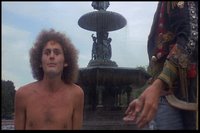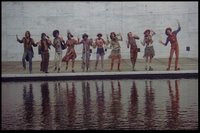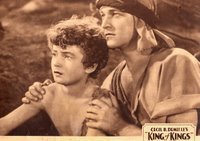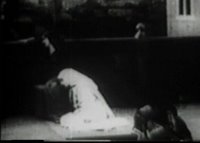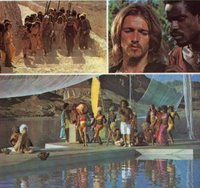Moses (1996) - Part 1 Scene Guide
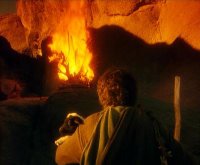 The Bible Collection's Moses was one of those films that really made me want to write more about films in general, and bible films in particular. The film is split into two parts, so I'll look at the first today, and the second later in the week. The scenes included in this film are as follows:
The Bible Collection's Moses was one of those films that really made me want to write more about films in general, and bible films in particular. The film is split into two parts, so I'll look at the first today, and the second later in the week. The scenes included in this film are as follows:Birth of Moses - (Ex 2:1-2)Notes
Death of the infants - (Ex 1:22)
Moses put on the Nile - (Ex 2:3-4)
Baby Moses discovered - (Ex 2:5-10)
[Extra-Biblical Episodes - Moses grows up]
Moses slays an Egyptian - (Ex 2:11-12)
Moses rescues Jethro's daughters - (Ex 2:16-20)
Moses, Zipporah and Gershom - (Ex 2:21-22)
Ramsees I Dies - (Ex 2:23)
Burning Bush - (Ex 3:1-4:17)
[Extra-Biblical Episodes]
Moses returns to Egypt - (Ex 4:18-20)
Aaron meets Moses - (Ex 4:27-28)
Moses and the elders - (Ex 4:29-31)
Moses and Pharaoh - (Ex 5:1-6)
Bricks without straw - (Ex 5:7-19)
Moses's staff and Pharaoh magicians - (Ex 7:10-13 )
Plague of Blood - (Ex 7:14-24)
Plague of Frogs - (Ex 8:1-15)
Plague of Hail - (Ex 9:13-33)
Plague of Locusts - (Ex 10:1-20)
Plague of Boils - (Ex 9:8-12)
The Passover - (Ex 12:1-28)
Death of the Firstborn - (Ex 12:29-30)
Pharaoh frees the Slaves - (Ex 12:31-32)
The Exodus - (Ex 12:33-42)
Pharaoh Changes his Mind - (Ex 14:5-12)
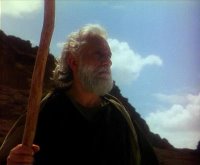 Although the film's narrative starts with the events at the beginning of Exodus the opening scene is actually of an older Moses. The camera circles him as an old man on his knees in prayer before going to the start of the story. It's an interesting way to start the film as there is no dialogue, internal or external commentary, or anything that links this opening shot with the start of the story. Moses, of course, has traditionally been associated with the authorship of Exodus (and of the whole five-book Torah in general), it would seem that this is the film-makers way of referring to that tradition. Whilst the text is largely devoid of the literary flourishes one would expect (at least today) from such an auto-biographical work, tradition, at least, has asserted that we hear it through Moses's lips. It is not surprising then that in the cinematic version of his story we see the events through Moses' eyes.
Although the film's narrative starts with the events at the beginning of Exodus the opening scene is actually of an older Moses. The camera circles him as an old man on his knees in prayer before going to the start of the story. It's an interesting way to start the film as there is no dialogue, internal or external commentary, or anything that links this opening shot with the start of the story. Moses, of course, has traditionally been associated with the authorship of Exodus (and of the whole five-book Torah in general), it would seem that this is the film-makers way of referring to that tradition. Whilst the text is largely devoid of the literary flourishes one would expect (at least today) from such an auto-biographical work, tradition, at least, has asserted that we hear it through Moses's lips. It is not surprising then that in the cinematic version of his story we see the events through Moses' eyes.The film only shows six plagues (Blood, frogs, hail, locusts, boils, and death of the firstborn), and even these are out of order. Interestingly, not all of the accounts of the 10 plagues in Exodus were in the original sources. The main source for them is the 'Yahwist' source, which featured seven or eight plagues (Blood, Frogs, Flies, Livestock, Hail, Locusts, Death of Firstborn and possibly the Plague of Darkness, although some list this as originating with the 'Elohist' source). This was later enhanced by two from the 'Priestly' source (Gnats and Boils). However, there is no real correlation between this film's choice of plagues and any one particular source. The use of Ten Plagues of judgement is possibly to mirror the Ten Commandments that Moses will also bring from God. Although whereas the first group of ten gradually build towards a climax, the later Decalogue starts with the greatest commandment and lists the others as being its logical outworking.
 Whilst the first part of the story is fairly conservative in its scene selection, opting to go for the most popular episodes as expressed by the wealth of previous artistic interpretations of the story, it also subverts the most well-known version of this story to audiences today, namely Cecil B. DeMille's The Ten Commandments. It does this by highlighting parts of the text that DeMille ostracizes in order to present a classically heroic Moses. So here Moses stutters (Exodus 4:10), and has Aaron do his early bidding. His pleas that God's chose another liberator are heartfelt, unlike Heston's Moses who appears to be simply being humble.
Whilst the first part of the story is fairly conservative in its scene selection, opting to go for the most popular episodes as expressed by the wealth of previous artistic interpretations of the story, it also subverts the most well-known version of this story to audiences today, namely Cecil B. DeMille's The Ten Commandments. It does this by highlighting parts of the text that DeMille ostracizes in order to present a classically heroic Moses. So here Moses stutters (Exodus 4:10), and has Aaron do his early bidding. His pleas that God's chose another liberator are heartfelt, unlike Heston's Moses who appears to be simply being humble. That said the film also goes beyond the text to subvert DeMille. So Moses always seems awkward and out of place in Pharaoh's palace - almost faintly ridiculous. His Hebrew ancestry, whilst unknown to Pharaoh, are known by Ramsees II amongst others - there is no great discovery. His rescue of Jethro's daughters is more due to his bluff and quick wit than his athleticism and power.
 Perhaps the most significant place where Moses subverts DeMille by returning to the original text is in the parting of the Red Sea. In both of DeMille's version of this incident the parting of the seas is almost instantaneous, and dramatic. However, the text of Exodus actually states that "all that night the LORD drove the sea back" (Ex 14:21). Here, Lionel Chetwynd's teleplay works the drama in another fashion by ending the first half of the film with Moses and the Israelites still waiting God's deliverance whilst the Egyptians close in. Given that the play was originally made for TV this cliff-hanger will have sent many back to their bibles to view the story afresh for the first time, finally liberated from DeMille's showmanship.
Perhaps the most significant place where Moses subverts DeMille by returning to the original text is in the parting of the Red Sea. In both of DeMille's version of this incident the parting of the seas is almost instantaneous, and dramatic. However, the text of Exodus actually states that "all that night the LORD drove the sea back" (Ex 14:21). Here, Lionel Chetwynd's teleplay works the drama in another fashion by ending the first half of the film with Moses and the Israelites still waiting God's deliverance whilst the Egyptians close in. Given that the play was originally made for TV this cliff-hanger will have sent many back to their bibles to view the story afresh for the first time, finally liberated from DeMille's showmanship.Labels: Bible Collection (The), Moses, Moses (1996), Scene Guides














